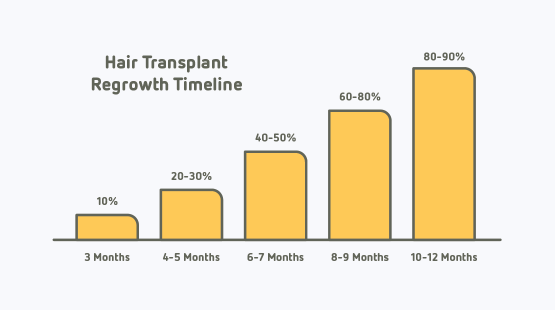A Guide to Hair Transplant Success Rates
Hair transplantation surgery has come a long way in recent years. Technological developments in how the procedure is performed have allowed it to become safer and more efficient, thereby raising the overall hair transplant results and success rate.
However, the top-most questions among prospective patients are 'do hair transplants work' and 'how successful are hair transplants?'
While it can be difficult to provide one definitive answer to this — especially as there are different techniques used for the surgery — the estimated survival rates for transplanted hair grafts is around 90-95%. In the majority of cases, this will mean that the hair transplantation will be successful and the patient pleased with the result, although full results can take up to 18 months to become visible.
To analyse this in more detail, we’ve created a hair transplant success rate guide. Here, we’ve looked into exactly what a hair transplant is, how success varies across the different techniques used, as well as the various factors which can have an effect on the overall hair transplant results. If you are looking for more general information, you can visit our hair transplant overview where you can find everything in one place.
Find the Right Hair Transplant Specialist at a Fraction of the Cost
Qunomedical only lists hair transplant clinics and doctors that have been thoroughly vetted with quality and affordability in mind. Contact us for your 100% free, non-binding assessment.
Hair Transplantation Surgery: A Brief Outline
A hair transplant is a minimally invasive procedure for men or women who are losing hair. The treatment involves the transplantation of hair follicles from one part of the head, known as the donor area, to the bald or thinning part, known as the recipient area.
There are a few different methods for carrying out a hair transplant. The first — and most commonly used — technique is known as follicular unit extraction (FUE). During FUE, follicular units, or grafts, which contain around 1-4 hairs, are extracted one by one from the donor area. Small incisions known as channels are then created in the recipient area and the follicular units are individually inserted to create natural-looking results.
Other common hair transplant techniques include direct hair implantation (DHI) — which doesn’t require channel creation thanks to the use of a specialist tool known as a Choi Implanter Pen — and follicular unit transplantation (FUT), although the latter method has become less common in recent years. However, it’s worth noting that DHI may not necessarily be an alternative to FUE in many cases. DHI is usually a more suitable option for lowering the hairline rather than increasing overall density. However, this is something that can be discussed with your doctor prior to undergoing treatment.
Hair Transplant Results: Success Rates and Realistic Goals
Thanks to technological advancements, hair transplantation surgery is now considered an effective and successful procedure. However, defining what constitutes a successful hair transplant will be specific to each individual patient, depending on your goals going into the treatment.
For some, it may be lowering the hairline, while for others it may be increasing the density around the crown. Therefore, before undergoing surgery it’s important to have detailed discussions with your doctor about what the transplant can realistically achieve. This will help to put the final results into perspective and allow you to accurately judge the outcome of the procedure.
Do Hair Transplants Work?
Graft survival rates following a hair transplant are between 90-95%. This essentially means that hair that’s transplanted from the donor area into the recipient area should remain in good condition.
The hair transplant success rate is analysed in accordance with patient satisfaction levels. In fact, a 2016 study surveyed former hair transplant patients who’d undergone FUE using a combination of donor hair from their head, as well as from their body or beard. The study followed-up with these patients around three years after their treatment and recorded an average satisfaction rating of 8.3 out of 10, attesting well to the FUE hair transplant success rate.
When assessing hair transplant success rates it’s important to remember that final results can take some time to show. Following the surgery it’s likely that you’ll experience what’s known as the ‘shedding phase’, a process by which up to 90% of the transplanted hair falls out. This doesn’t mean that the procedure wasn’t successful though. Rather, this is a natural and transient reaction to the surgery and the hair will gradually begin to recover and re-grow in time. It normally takes around 12 months for the final results of a hair transplant to become apparent, although in some cases it may take up to 18 months.
As for how long it will last after that, a professional and experienced surgeon will be able to give you fuller hair that will last a lifetime, though natural ageing will still affect the hair as normal. In other words, a hair transplant after 10 years will still hold its line, but will look natural with the rest of your features as you've gone older. Read more about this topic here.

Find the Right Hair Transplant Specialist at a Fraction of the Cost
Qunomedical only lists hair transplant clinics and doctors that have been thoroughly vetted with quality and affordability in mind. Contact us for your 100% free, non-binding assessment.
Are There Any Factors That Can Affect Your Hair Transplant Success Rate?
While overall hair transplant success rates have been steadily increasing in recent years, there are a few important factors which can have an effect on this. These are important to bear in mind, especially since the details of hair transplantation surgery are often unique to the individual undergoing treatment. Below, we’ve outlined some of the most important factors in more detail.
1. Type of Hair Transplant Chosen
2. Type of Hair
3. Clinic and Doctor Quality
4. Post-Treatment Care
5. Supporting Treatments
As previously mentioned, a hair transplant that’s carried out by a qualified professional should last a lifetime. The main reasons behind this relate to the genetic nature of hair follicles. It’s the hair follicles themselves, not the scalp, that have the genetic predispositions related to hair loss and balding. Therefore, during a hair transplant, hair follicles are taken from areas which aren’t thinning or balding, as they’re still healthy and haven’t been affected by hair loss. Once these healthy follicles have been transplanted to the bald or thinning area, they retain their resistance to hair loss. Regardless of where the healthy follicles are placed, they will retain their original characteristics. Typically, these follicles will remain healthy and therefore further hair loss usually doesn’t occur.
Following your hair transplant, don’t despair if you’re not immediately seeing as much growth as you’d like. Typically, 10% of the transplanted hair should grow back after around three months, with full growth showing between 10-12 months after treatment. However, in some cases, it may take up to 18 months for the final results to appear.
Going Into The Surgery: Your Personal Factors
Everyone's hair situation is unique, so it's also pertinent to ask whether results differ between people, or even if a hair transplant is something everyone can do. Hair transplants work based on a number of personal factors that we have highlighted below.
1. Choosing a High-Quality Doctor and Clinic
2. Age of the patient
3. Donor Area Density
4. Donor Area Size
The Future of Hair Transplantation Surgery
Hair transplantation surgery has come a long way since it’s first mention within medical academia back in 1939. New technologies and improvements are continually being developed worldwide to improve the efficiency and effectiveness of the procedure.
One of the most exciting prospects that may have the potential to significantly boost the success rate of hair transplant results is the development of stem-cell hair transplants. The use of stem-cell enriched injections are already commonly used alongside a hair transplant, however, standalone stem-cell hair transplants are currently undergoing clinical trials and are estimated to be ready for use within the next few years. Until then though, reliable methods like FUE and DHI still offer great success rates and natural-looking results.

Patient manager
Frieda
Your personal Patient Manager
Let's talk
Still unsure? Feeling overwhelmed? Talking to a real person can give you the guidance and reassurance needed. You don’t have to do it alone. Let’s find the right doctor together.
